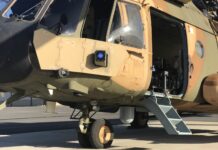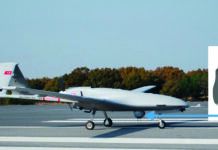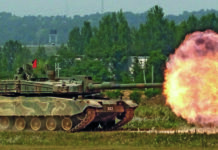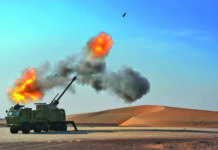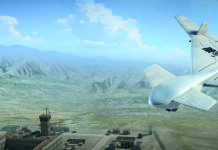Speed is the crux of battle. The side that can decide and act faster
than the enemy has a significant advantage.
Imagine a single network that connects joint sensors in all domains; land, sea, air, space, and cyber and includes relevant information concerning information warfare while monitoring the Electromagnetic Spectrum (EMS). Now picture a setting where warfighters at all levels have access to the information pertaining to their mission and can visualise the operations and intent two-echelons above their own. Such connectivity speeds up decision-making and expedites the kill-chain. This is the promise of the US Department of Defence’s (DoD) Joint All Domain Command and Control (JADC2) concept.
JADC2 promises to enable cross-domain manoeuvre at machine speeds using Artificial Intelligence (AI). AI can assist commanders to accelerate the “observe, orient, decide and act (OODA) loop” across the full spectrum of combat operations. According to the Congressional Research Service Report (CRS), “Joint All Domain Command and Control (JADC2), dated 1 July 2021,” the DOD uses Uber as a metaphor for JADC2. “Uber combines two different apps—one for riders and a second for drivers. Using the respective user’s position, the Uber algorithm determines the optimal match based on distance, travel time, and passengers (among other variables). The application then seamlessly provides directions for the driver to follow, delivering the passenger to their destination. Uber relies on cellular and Wi-Fi networks to transmit data to match riders and provide driving instructions.” The concept of JADC2 is to deliver digital connectivity everywhere in the battlespace. It is more than just a faster way to connect sensors with shooters. As it matures, JADC2 will operationalise battlespace data and transform transform information into understanding.
How Will JADC2 Work?
“Technology is moving fast, but human institutions and organizations aren’t keeping up.” MIT Sloan professor Erik Brynjolfsson, co-author of “The Second Machine Age: Work, Progress, and Prosperity in a Time of Brilliant Technologies,” said on 22 February 2018, at the LinkedIn Speaker Series talk. The way to keep humans operating at faster speeds is to combine humans with computer intelligence. JADC2 requires an internet cloud and a rich sensor network in the battlespace. This cloud will enable the sharing of sensor information: intelligence, surveillance, reconnaissance, and targeting data. AI will then process the data, possibly using quantum computing, to recommend courses of action and targeting options for the human commander who will command and control using JADC2. This will merge human commanders with the speed of machines. Teaming humans with computer-assisted decision-making is often called the “centaur” concept of command and control.
Some people find the centaur concept unsettling, but it can also be viewed as an evolution of what we already do today. Tomorrow, you may think of it as normal. The first human to mount a horse was probably unnerving to those who witnessed it for the first time. Those who embraced the horse developed better hunting capabilities and mounted warfare. Enemies who were unmounted were at a distinct disadvantage in speed and striking power. Humans driving cars and airplanes are part of the man-machine interface that we accept as normal today. Currently, millions of people ask questions and get advice from devices enabled with the Lexus or Siri AI. This is a centaur approach to merge human and AI capabilities to access information to empower the human to make better, informed decisions. According to a separate CRS Study, Joint All-Domain Command and Control: Background and Issues for Congress, 8 July 2021: “As formations increase in complexity—particularly with formations designed for Joint All-Domain Operations—controlling these forces could potentially surpass the ability of human cognition, with algorithms used to help manage these forces. The US military has stated that it intends to keep humans involved throughout the decision-making process, but as US forces introduce more AI technologies into their decision-making apparatus, distinctions among the dimensions begin to blur.” In 2016, when JADC2 was being envisioned, Paul Scharre, an expert on autonomy in weapons and a combat veteran, wrote an article titled “Centaur Warfighting, The False Choice of Humans vs. Automation.” He stated that “…in many situations, human-machine teaming in engagement decisions will not only be possible but preferable… The best systems will combine human and machine intelligence to create hybrid cognitive architectures that leverage the advantages of each.” JADC2 is the evolution of that idea.
An Update on JADC2
In December 2019 and July 2020, the US military exercised multiple JADC2 elements. The first simulation involved the US Air Force’s Air Battle Management System (ABMS) using joint systems from all services, including commercial space sensors. A combined wartime simulation set in the Black Sea was the focus of the second exercise. This involved joint US forces operating with eight other NATO members. The focus of both tests exercised JADC2 data sharing and simulated target engagements.
Significant investment has been dedicated to the development of JADC2. According to the CRS July 2021 report cited earlier, “DOD requested US$302.3M for ABMS in FY2021 but was appropriated US$158.7M (a US$143.6M decrease) due to unjustified growth and forward financing. DOD also requested US$207M for 5G Congested/Contested spectrum research and development, seeking to develop spectrum sharing technologies and network security architectures.” JADC2 clearly is a priority for DoD.
DoD is in overall charge of the JADC2 effort, with the Joint Staff working on policies and doctrine while designating the US Air Force as the executive agent for technology development. The US Army is working on JADC2 issues under its Project Convergence programme, the Air Force with its ABMS programme, and the Navy with Project Overmatch. According to the CRS July 2021 study: “Air Force officials have argued that a JADC2 architecture would enable commanders to (1) rapidly understand the battlespace, (2) direct forces faster than the enemy, and (3) deliver synchronised combat effects across all domains.”
Developing a JADC2 Common Operational Picture
A major challenge for JADC2, once the network connectivity is reliable in a contested, degraded or denied battlespace, is to develop an All-Domain Operations Common Operational Picture (ADOCOP). An ADOCOP will enable commanders to visualize multiple domains and manipulate combat actions across domains. An ADOCOP would present information at AI machine speeds to synchronise the effects across all domains in real-time, thus providing predictive analysis. This ability is crucial to assist the human warfighter in conducting cross-domain manoeuvre. A JADC2 enabled ADOCOP will enable commanders to visualize actions in the land, sea, air, space, cyber, and information domains, thus gaining awareness of friendly emissions across the electromagnetic spectrum. An ADOCOP would empower commanders to understand the complexity of the operating environment by providing autonomous situation awareness and enable decision-makers to act in real-time to employ forces and assets across multiple domains.
To conduct cross-domain manoeuvre, commanders must not only see the relevant domains on-demand, in real-time, but must also employ predictive analysis. The hyper-speed of future battle renders real-time events as past actions for human cognition. To adapt to changing circumstances, the commander benefits from enhanced cognitive AI to predict what is likely to happen next. Real-time is not enough; predictive analysis is crucial. As the real-time fight is occurring, the ADOCOP will help commanders visualize the fight in “predictive time” and see how their actions might play out. Visualizing all domains in one, integrated common operational picture, and providing predictive analysis, is beyond human cognition and requires enhanced systems with robust AI. An ADOCOP is an enabler for JADC2 and the human commander’s interface with the AI. Those who master advanced methods to synchronize, visualize, predict, and execute combat in this multi-domain battlespace, with an ADOCOP, will secure a tremendous advantage over their adversary.
The Future of JADC2
The US military sees JADC2 as the evolution of command and control in the connected, digital age. AI is central to this evolution. Rapid data sharing can create a seamless AI assisted kill-web to allocate weapons’ effects precisely, at machine speeds, across a global, adaptable, and resilient network. According to a JADC2 information paper by Splunk Inc., an American technology company based in San Francisco, California: “For the first time, it’s realistic to imagine a scenario where highly advanced sensors deployed in ships, planes and tanks continually feed critical, real-time information back to headquarters. Then, using state-of-the-art AI and machine learning (ML) tools, commanders analyse the avalanche of incoming intelligence and make better decisions, faster.” The key is to transform the “avalanche of data” into an ADOCOP that a human commander can understand and employ.
In June 2021, Secretary of Defence Lloyd Austin approved a JADC2 development strategy document. Lt. Gen. Dennis Crall, USMC, Director, Command, Control, Communications and Computers/Cyber; and Chief Information Officer, The Joint Staff (J-6), announced at a press conference on 7 June 2021, that the approval of the JADC2 strategy “is a clear recognition by the Secretary on the nature of the fight we expect to have in the digital age. The second thing that is does, is that it brings together some rather disparate communities within the department and has us work together for a common cause.” In response, the US defence industry is jumping into the development process. Over 90 companies, big and small, are working on aspects of JADC2. In July 2021, the US Air Force selected 29 companies as awardees for a potential US$950M contract to develop elements of the common command-and-control platform. The other services are also investing heavily to bring JADC2 to reality. Under the guidance of the Joint Staff, the current programmes — the Air Force’s ABMS, the Army’s Project Convergence, and the Navy’s Project Overmatch — will combine with Space Force’s efforts to form America’s future digital warfighting system.
War is at an inflection point as the digital age rapidly unfolds. A major shift in warfighting is taking place with the implementation of JADC2. This shift will become the warfighting agent that will combine the best of human cognition with specially programmed AI to accelerate the OODA loop, enable the kill-web at machine speeds, and extend the warfighters ability to make the whole bigger than the sum of its parts. Speed is the crux of battle, and although AI can provide speed to assist decision-making, AI cannot understand “why?” AI requires an immense amount of data to simulate understanding. Only humans can apply understanding and purpose. The best command and control system will combine human and machine intelligence to create hybrid cognitive architectures that leverage the advantages of each. Merge AI with the best of human cognition, in a centaur approach, and you have a war winning combination. This is the goal of JADC2.




